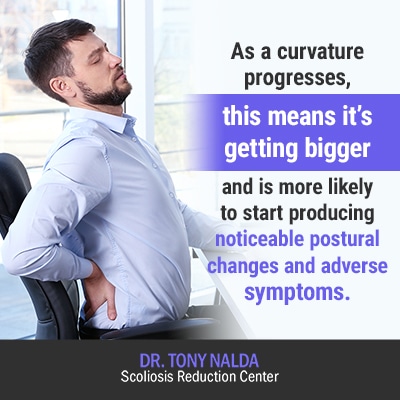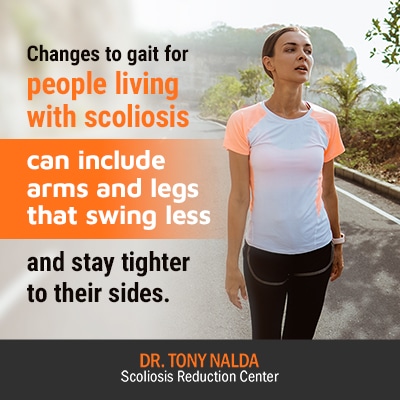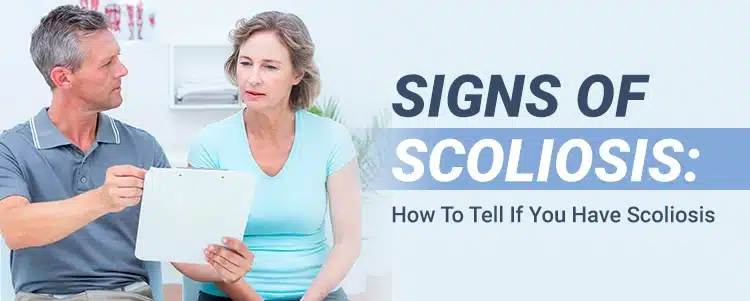With scoliosis, early detection of symptoms of scoliosis is particularly beneficial; this is because as a progressive condition, scoliosis is virtually guaranteed to get worse over time, if left untreated. The earlier scoliosis is spotted and diagnosed, the sooner treatment can be started.
Here are some of the signs of scoliosis to watch for:
- Head not centered over the torso
- Uneven shoulders
- One shoulder blade protruding more on one side
- Arms appearing to hang at different lengths
- Legs appearing to hang at different lengths
- Ribs protruding more on one side
- Presence of a rib arch
- Body appears to be tilted when standing
- Asymmetrical waste with one side that’s more curved
- Asymmetrical space between the arms and torso
- Abnormal spinal curvature that’s visible to the naked eye
- Changes to balance/coordination
- Changes to gait
- Clothing fitting unevenly
The Spine and Scoliosis
When a person develops scoliosis, this means they have a progressive spinal condition marked by an abnormal sideways curvature that includes rotation. The cervical spine, which is the uppermost part of the spine, can also be affected by scoliosis, impacting neck mobility.
When the spine develops an abnormal curvature, this means there is a loss of the spine’s natural and healthy curves, and this doesn’t just impact the spine at the site of curvature, but throughout as the spine’s overall biomechanics are disrupted.
Along with rotation, the curvature also has to have a Cobb angle of more than 10 degrees to be diagnosed as scoliosis; this is a measurement obtained via X-ray that classifies how far out of alignment a patient’s spine is.
The higher the Cobb angle, the more severe the condition is. Before moving on to the signs of scoliosis, it’s important to first understand the condition’s different severity levels:
- Mild scoliosis: Cobb angle measurement of between 10 and 25 degrees
- Moderate scoliosis: Cobb angle measurement of between 25 and 40 degrees
- Severe scoliosis: Cobb angle measurement of 40+ degrees.
Condition severity is an important piece of information because it informs the treatment approach moving forward and indicates potential symptoms, as well as giving us an idea of a patient’s ‘likely’ rate of progression.
I say ‘likely’ because while there are certain patient and condition characteristics that can help us predict a patient’s progressive rate, there is no definitive means by which we can 100-percent gauge how fast, or slow, a patient’s condition will progress.
As such an important aspect of scoliosis, let’s discuss progression in more detail.
Scoliosis and Progression
Reaching a diagnosis and getting answers to questions about what is happening in your body is always a good thing, but when it comes to progressive conditions like scoliosis, early detection is especially important in terms of potential treatment success.
When it comes to the condition’s most common form, adolescent idiopathic scoliosis (AIS), diagnosed between the ages of 10 and 18, we know this age group is at a particularly high risk of progression because they have not yet reached skeletal maturity; AIS accounts for 80 percent of known diagnosed cases.
Early detection allows for timely scoliosis treatment, which can include observation, bracing, or surgery depending on the severity.
We might not know what causes the onset of AIS, but we do know it’s number-one trigger for progression: growth and development.
Conversely, in adult scoliosis, we know they are not at such a high risk of rapid progression because they have already reached skeletal maturity and no longer have that big progression-trigger.
Instead, scoliosis progression in adults tends to be slower and has more of a cumulative effect. Even at a relatively slow progressive rate of a degree a year, over 10 years, that can add up to a significant degree of curvature.
This is why I place such a strong emphasis on early detection. The goal is to diagnose a condition while it is still in its mildest stage, before it progresses into the moderate and severe stages.

As a curvature progresses, this means it’s getting bigger and is more likely to start producing noticeable postural changes and adverse symptoms.
Knowing how to tell if you have scoliosis means understanding the indicators for the condition, so let’s move on to discussing the signs of scoliosis in more depth and detail.
Understanding the Signs of Scoliosis
The best time to treat scoliosis is when the condition is mild, but in order for that to happen, people have to be educated on the signs of scoliosis that they should be looking for.
The most common type of scoliosis, called idiopathic scoliosis, has no identifiable cause and is often diagnosed during adolescence.
Depending on condition severity, signs can range from subtle to overt, with many only noticeable to experts who are aware of exactly what to look for.
As scoliosis isn’t a static condition, the goal is to reach a diagnosis as early as possible before it becomes more severe. Not only do we want to spare patients the hardships associated with the higher stages of progression, we also know that smaller curvatures are easier to treat.
Smaller curvatures are easier to treat because, generally, spines lose flexibility as a curvature progresses, the body has not had as much time to adjust to the curvature, and put simply, they are less complex than larger curvatures.
Let’s break down the earlier list of signs of scoliosis.
Postural Changes
The postural changes that accompany scoliosis will range significantly based on factors such as condition severity.
In the condition’s early days, it rarely produces noticeable functional deficits, and often, postural changes are too subtle for anyone other than an expert to notice; this can make it difficult for a person to be aware of what is happening in their body until the condition starts producing more noticeable symptoms.
The most common postural changes to look for involve an overall asymmetrical appearance to the body.
Uneven shoulders and hips are early postural changes to look for, along with arms and legs that appear to be hanging at different lengths. A rib arch is a sign most commonly associated with scoliosis in the thoracic spine, or middle back, and basically, any indication that the body is becoming, or has become, asymmetrical could be an indicator for scoliosis.
Changes to How Clothing Fits
We all know how fast adolescents and teenagers outgrow their clothes, but if clothing suddenly seems to be hanging differently, this could be due to asymmetrical changes that are happening to the body.
Scoliosis in the lumbar spine, or lower back, can cause one side of the waist to appear higher, affecting how pants fit.
If shirt sleeves and cuffs always seem to be uneven, or shirt necklines always seem to be leaning more to one side, this is a potential sign that the body is becoming less symmetrical and scoliosis could be a factor.
Balance/Coordination Issues
There are a lot of uneven forces at work with scoliosis. As the spine bends and twists out of alignment, the body does its best to adjust.
This can shift the body’s center of gravity and make balance and coordination extra challenging. In addition, people with scoliosis can have problems with proprioception (the body’s ability to recognize its position without visual cues).
Physical therapy can help improve balance and coordination in scoliosis patients by strengthening the muscles around the spine.
For someone without scoliosis, standing on one foot with the eyes closed is a simple task, but for people with scoliosis, this can be particularly challenging.

I can tell a lot about a patient’s condition by how they walk. Changes to gait for people living with scoliosis can include arms and legs that swing less and stay tighter to their sides.
Juvenile scoliosis, diagnosed in children aged 4 to 10, can also lead to noticeable changes in gait.
A reduction in the normal counter-rotating motion in the hips and shoulders during walking can also become evident. If the motion itself seems asymmetrical, this is a potential sign of scoliosis.
I didn’t include ‘pain’ in the initial list of scoliosis signs to watch for because in AIS, pain is rarely part of living with scoliosis, so is not a reliable sign for the condition’s most common form.
In AIS, as they have not yet reached skeletal maturity, their spines are constantly growing, and this lengthening motion counteracts the compressive force of the curvature, which is what’s known to cause pain in adult patients.
Adults with scoliosis tend to experience pain very differently, and it is most often pain that brings adults in for a diagnosis. In fact, it’s not uncommon for cases of AIS to remain undiagnosed until adulthood, when more severe symptoms, like pain, signal the presence of the condition.
Headaches, however, due to fluctuating CSF (cerebrospinal fluid) levels and a certain amount of muscle pain can be part of both the adolescent and adult experience of scoliosis.
When the Puzzle Pieces Come Together
Often, we are like detectives, looking for clues to what is happening inside our bodies. When it comes to scoliosis, having one or two of the aforementioned signs present doesn’t necessarily guarantee that scoliosis is an issue.
Infantile scoliosis, diagnosed in children under the age of 3, is another type that requires early detection and monitoring.
Sometimes, issues with postural changes are little more than just chronic bad posture, which is not the same as scoliosis, or awkward changes associated with puberty; however, what the presence of any number of these signs does indicate is a need for further testing.
Scoliosis signs give us pieces of a puzzle, but it’s not until an official assessment and X-ray can be done that a complete picture emerges.
Considering the benefits of early detection, getting screened for scoliosis is never a bad idea, especially when some of the aforementioned signs are present.
Recognizing the Signs of Scoliosis in Children and Teens
Changes in Posture and Appearance
Scoliosis often presents noticeable changes in a child’s posture. Parents may observe uneven shoulders, shoulder blades, or hips, a visible curvature in the spine, or clothes that don’t hang evenly. Other signs include a tilted eyeline, protruding ribs, or one leg appearing shorter than the other. These visual cues are key indicators that a spinal issue may be present.
Difficulty Balancing
Beyond visible posture changes, scoliosis can affect a child’s sense of balance and coordination. Many individuals with scoliosis struggle with proprioception, the body’s ability to sense movement and position. A simple test—having your child stand on one leg with their eyes closed—can reveal potential difficulties with balance, signaling a need for further evaluation.
Tiredness and Fatigue
Scoliosis can also cause excessive fatigue, as the muscles around the spine must work harder to maintain proper alignment. In more severe cases, the spinal curve can even impact breathing, further contributing to tiredness. If your child frequently complains of exhaustion despite little physical exertion, scoliosis could be a factor.
What to Do Next?
If you recognize these signs, consulting a doctor for an examination and X-rays is the next step. While some experts may recommend a “wait and see” approach, early intervention can lead to more effective treatment. Chiropractic-centered care, like that offered by the Scoliosis Reduction Center®, may help your child live an active, unrestricted life.
Conclusion
Early diagnosis is essential when it comes to the best possible treatment outcome. The early signs of scoliosis can be subtle, so it’s especially important to be aware of the signs you should be looking for. Early detection of scoliosis is also essential for ensuring a child’s long-term health and well-being. By recognizing the signs parents can seek timely medical evaluation and treatment. Proactive care can help manage scoliosis effectively, allowing children to stay active and thrive. If you suspect scoliosis, consulting a specialist can provide the best path forward for your child’s health.
Early diagnosis allows for the most effective scoliosis treatment, which can prevent the condition from worsening.
Uneven shoulders and hips are often the earliest postural changes to appear, and because abnormal curvatures have it in their nature to get worse over time, the sooner we can reach a diagnosis, the better.
When scoliosis is diagnosed early, it gives us the best chance to develop the most effective treatment plan, but it is still important to understand that even in some cases that are caught early, progression can still happen quickly despite our best efforts to control it.
That being said, in the vast majority of cases, there are huge benefits to catching a condition early and starting treatment, and knowing the signs of scoliosis to look for can most definitely lead to early detection and a better treatment outcome.





